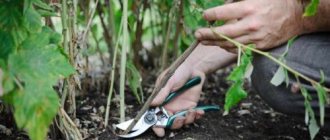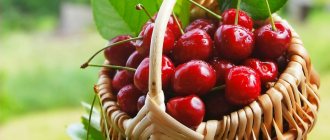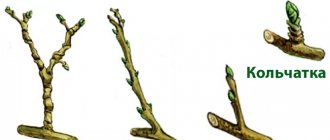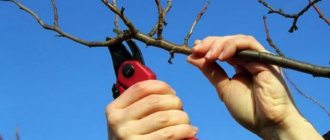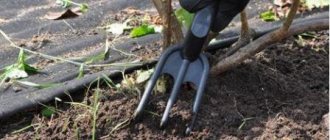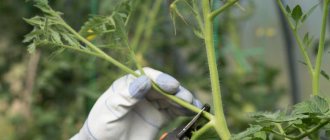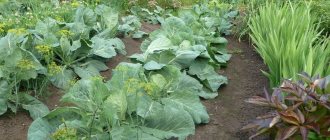Why prune raspberries in the fall?
The first reason is the removal of old shoots. Raspberries have a two-year fruiting cycle. In the first spring, trunks are formed, and the next year berries appear on them. After fruiting, they gradually dry out under the pressure of young growth.
The second reason is the thickening of plantings. It has been noticed: the more branches there are in the bush, the smaller the berries. There are more insects in dense raspberry forests. Productive varieties run wild without pruning - the taste of the berries deteriorates. When raspberries are left with a few stems, they receive adequate nutrition. It is convenient to harvest when there are no dense thickets. If the rows are visible, all the berries are visible.
How to prolong the fruiting of raspberries?
To increase the fruiting period of raspberries, some gardeners shorten the shoots to different lengths
.
Some stems are cut by 10-15 cm, others by 20-30 cm, some in half, and still stems with a quarter of the shoot are left.
Thus, the lightly pruned stems will begin to bear fruit first, and the most pruned stems will finish bearing fruit (in August).
The yield from the most pruned stems will be less, but the berries will be large. Thus, fruiting extends throughout the entire season.
Timing for pruning raspberries in autumn
The time for autumn pruning of raspberries depends on the climatic characteristics of the region. The beginning of autumn is considered the most successful time, but this concept is flexible. You can take up the pruning shears immediately after picking the last berries.
Recommended dates for autumn pruning by region:
- southern regions - from the end of July to the first week of October;
- central Russia - last week of August - mid-September;
- Ural, Siberia, other areas of risky agriculture - August;
- northern regions - mid-August - early September, work must be carried out as soon as possible.
It is more convenient to work with raspberries on dry days. The soil will warm up, the branches will dry out, and will yield better to the blades. If the plantings are large, you can work on them for several days. The main thing is to give the plants a rest before wintering.
Autumn pruning is called so conventionally. Gardeners get rid of excess young growth in raspberry fields throughout the summer, when they loosen the soil and free it from weeds. The tops of young branches that are too elongated are pinched during fruiting, the berries are collected every three days, otherwise they will all end up on the ground. If you want to grow strong raspberry trees, you should care for them regularly.
When to prune raspberries for the winter: timing
The success of the enterprise depends on the correct choice of timing and the specifics of the regional climate. There is no universal answer to the question of when is the best time to do this.
Gardeners are sure that the time can vary from late summer to mid-autumn, it all depends on the type of plant and the onset of really cold weather.
In non-repairing varieties, fruiting occurs only on last year's shoots, so pruning older plantings benefits the plant without forcing it to waste its potential on something that will certainly wither or die after frost.
According to the lunar calendar
Favorable days for pruning can be found in the gardener's lunar calendar. For such work, do not choose days with negative energy, full moon and new moon. It is noted that the most favorable time is in the waning phase.
Pruning does not cause injury, since during this period reverse sap flow occurs, all biological fluids rush to the roots. Having decided on the month of the year, you can choose the most favorable days in the period of decreasing size of the night star.
By region
In areas with a harsh climate, they do not prune remontant varieties of raspberries, but with other types there is an excellent guideline - about 3 weeks before the onset of the first frost. This will require a long-term weather calendar. Of course, you can be guided by approximate deadlines:
- in Siberia, the Urals and Altai it is better to devote mid- to late August to this;
- in the south you can plan pruning until the second ten days of October;
- when to prune raspberries for the winter in the Moscow region and in the middle zone can be decided by the weather - the time available is from mid-August to mid-September.
Determination of timing may be adjusted by weather conditions. Farmers with long experience expect dry and sunny weather. In this weather, the branches are easier to use for tools, and walking on dry soil is much more convenient.
A good owner pinches out young branches during the fruiting period, and removes excess young branches by weeding the raspberry tree and loosening the soil.
Shoot height
Pruning raspberries in autumn - picture
Stems with brown trunks and thickening shoots are cut out to the very roots. Place the pruning shears at ground level or slightly deeper. If you leave hemp above the surface, insects and pathogenic bacteria will settle in them. The remaining branches are usually shortened to 2 meters to make it convenient to pick berries, but at what height to cut raspberries in the fall, you should also choose the type of berry.
Tops that are too elongated are cut off to stimulate the formation of lateral processes. There are many inflorescences on them. The sooner you pinch them, the better the trunks will branch. Some productive varieties produce the main harvest on the lateral shoots.
How to properly prune remontant raspberries to increase yield
To obtain the maximum yield from the bushes, it is recommended to completely cut out this variety during autumn pruning and obtain a bountiful harvest in late summer - early autumn. In this case, the berries will be larger and the yield will be higher than with two fruitings.
If you cut off the top of annual shoots that have grown up to a meter, the yield can be increased even more due to the appearance of a larger number of lateral fruit-bearing shoots.
When using this technique, keep in mind that fruiting will occur a little later, but will last longer. Therefore, the climatic features of the area should be taken into account. This technique will be most relevant for the southern regions and the middle zone.
Rules and methods of pruning
Remove to ground level:
- 2-year-old branches with berries on them;
- crooked and damaged young shoots;
- thickening tree trunks (thinning out bunches).
Novice gardeners mistakenly trim the edges of a raspberry bush in the fall, leaving the center untouched. The yield from such a “haircut” does not increase significantly. It is necessary to leave 5-7 branches around the entire circumference of the raspberry, be sure to thin out the middle so that the plantings are ventilated and the flowers will be well pollinated.
It is important to prepare the tool: the cutting surfaces are disinfected so that viruses do not get into the trunks, leading to disease and even death of the plant.
Basic rules for pruning raspberries in the fall:
- the remaining branches should be arranged like a fan, then they will not overlap each other;
- First, the rough two-year-olds are removed, then the soft young ones are cut out;
- broken, damaged branches are not left, they are removed at the root;
- shoots that appear in mid-summer are plucked out at the base; they will freeze and will not have time to ripen.
Trimming methods:
- formative: fast-growing varieties are pruned by 1/3;
- sanitary: removal of old and diseased branches;
- usual - getting rid of thickening, broken, two-year-old branches.
When is it better - autumn or spring
Let us remember: the main pruning is carried out in the fall, and with the onset of spring - sanitary pruning. In the spring, they wait for the snow to melt and go to the raspberry field to cut off branches broken off by snow and bad weather. They also remove frozen shoots and cut off the top parts from the branches that will produce a harvest this year.
Pruning raspberries for the winter is carried out after harvesting: all two-year-old shoots that bear fruit must be eliminated. Old branches practically do not bear fruit, except perhaps a small, tasteless berry. Therefore, after harvesting, these shoots are removed at the root. Then weak and diseased branches are removed.
The essence of winter pruning is to prepare the raspberry tree for the frosty season and ensure consistently high yields.
Pruning remontant raspberries in autumn
Pruning remontant raspberries in the fall - photo
Remontant raspberries, which bear fruit until late autumn, are in no hurry to prune; they are waiting for the last berries to ripen. They also appear on annual shoots. After the last wave of raspberry fruiting and shedding of foliage, 2-year-old bushes are cut out at the root, and the tops of annual bushes are cut off by 15–20 cm.
You should not spare one-year-old branches; after pruning, they will have time to lay new buds. In the spring they will immediately give growth not only upwards, but also on the sides. If you prune remontant varieties as usual, the yield will decrease. It is best to do remontant plantings separately from other species. Then there will be no confusion. From young shoots, no higher than 60 cm, leave no more than 3 strong branches. The rest is mercilessly removed, preferably from the roots. Proper pruning increases next year's harvest.
How and when to prune in spring
Spring pruning should be completed before the main sap flow begins. They focus on the arrival of spring in their region.
In order for the bush to grow not straight up, but to begin to bush, the raspberries need to be shortened by 13-15 cm to a strong bud
Frozen, broken shoots need to be cut back to a healthy bud.
If you shorten the shoots to different heights, you can extend the fruiting period of the entire raspberry tree. Heavily cut bushes bear fruit later.
The next stage of pruning is the appearance of massive growth, which is removed at the root with a shovel. If you plan to leave a few for fruiting next year, then choose strong and strong ones.
Overgrowth greatly interferes with the plant’s ability to concentrate all its energy on fruit growth.
Please note that if you do everything correctly in the spring , then in the fall there will be 16-20 healthy young shoots per meter of the ridge.
Further preparation for winter
Work on the berry patch continues. The plant needs to be fed so that it has enough strength to prepare for winter. The soil needs to be saturated with moisture; succulent shoots tolerate frost better. The ground is cleared of cuttings and weeds. Mulching is done to retain moisture. It is worth telling about each operation in more detail.
Proper feeding
Removing unnecessary branches is not the final stage of preparation for winter; you still need to know how to feed raspberries in the fall after pruning.
In the fall, after pruning, add some natural ingredients:
- Manure is incorporated into the soil in a thin layer. The unrotted one performs the function of biofuel and gives heat to the roots. Last year's is a source of nutrients. The most useful manure is horse manure, followed by cow manure. It is better not to place pork with sawdust on raspberries; first they let it rot well.
- Chicken droppings in their pure form burn plants. It is diluted in water at the rate of 200 mg per bucket.
- Compost is more valuable in nutritional value than humus; it is laid out in a layer of 5–7 cm around the shoots. The norm per 1 m2 is up to 7 kg (this is a bucket of dry).
- Take rotted peat, mix it with wood ash, add a glass to a bucket.
After feeding, raspberries replenish their reserves of nutrients and lay flower buds. Per 1 m2 add 40 mg of superphosphate and 20 mg of potassium sulfide. These comprehensive supplements contain essential macronutrients.
Sanitation
Spraying with fungicides protects against fungal diseases, rot, and mosaic. Bordeaux mixture is effective against insects. It is advisable to carry out the treatment before the foliage has completely fallen. Liquid laundry or green soap is added to the solution for better adhesion.
Watering
Usually by the end of summer in temperate latitudes it begins to rain, then watering is not required. If August turns out to be dry, the soil is well watered so that it is saturated to a depth of 40 cm. With the onset of frost, watering is reduced. During this period, the shoots will become woody and gain the necessary strength.
Mulching
Mulching serves to protect the roots from extreme cold until permanent snow cover has established. For mulch use:
- dry humus;
- rotted sawdust;
- straw;
- crushed bark.
Cover the soil with a layer of up to 8 cm. It has been proven that this is enough to prevent the ground from freezing to a great depth. In the northern regions, the layer is doubled; only in the spring, after the snow has melted, it is important to clear the mulch in time, otherwise the trunks will prop up and crack from below. It is recommended to add fresh pine needles to the mulch to repel mice.
Frost protection
When is it better to cover raspberries well:
- if it is a productive sugary variety, such berries are heat-loving;
- severe frosts are expected;
- winters with little snow;
- if the raspberry is thornless, it will become easy prey for rodents.
Proper preparation consists of bending the shoots to 1/3 of the height. As soon as the morning performances begin, you can sprinkle the prepared rows with spruce branches. It is convenient to tie branches to wooden pegs; you can drive nails into them on all sides. The end of the twine is wound onto the shoots and pulled down, bending them at an angle of 60°.
Bushes are protected from rodents with netting, barbed wire or spruce branches, and poisonous baits are laid out on cleared ground. Residents of northern latitudes are advised to bend raspberries as low as possible and cover the shelters with tops and dry branches. In windy areas, snow protection is made - sheets of plywood or polycarbonate are installed on the leeward side.
The branches bend when the air temperature is above +10°C; in the cold they become fragile.
Types of pruning
Practicing gardeners have developed many options for pruning berry bushes. The most popular are: forming and cutting branches “according to Sobolev” and regular pruning. Gardeners also willingly use double pruning, which ensures the ripening of the crop over time. Clearing the raspberry bush makes it easy to care for the plantings in the future.
Regular
In the fall, old branches, as well as those with mechanical damage, weakened and frail, are removed from the raspberry tree. Also, during clearing, the interval between the plants left must be observed.
Some gardeners consider autumn pruning of the tops of young bushes to be correct, others are categorically against such a procedure and believe that it should only be carried out in the spring. Therefore, the gardener should carry out this part of pruning based on his preferences and experience.
Double
Check out
When and how to prune raspberries correctly?
To get the effect of extended fruiting, gardeners resort to tricky pruning: on the same bed, shoots are cut to different heights; on some, the top 15 cm long is cut off, and on others, the cuts reach 25–30 cm. Branches cut in this way begin to bear fruit at different time.
Depending on the amount of pruning, the interval between periods of berry ripening reaches 10–12 days. This pruning is good for getting fresh berries for the table throughout the summer. If the gardener wishes, he can trim not according to two length parameters, but, for example, four or five.
For example, part of a raspberry tree is cut at 15 cm, another part at 20 cm, the next at 25 cm, another at 30 cm and the last at 40 cm. Experiments with cutting length are recommended for owners of large raspberry plantations; this will make it possible to rush to pick berries and not allow them to overripe on the bushes.
Video: double pruning raspberries
Sobolev method
Trimming bushes using the Sobolev method is very popular in growing garden raspberries. The technique of this pruning is quite simple and effective, thanks to which even beginners in gardening can carry out the procedure efficiently.
Trimming according to Sobolev:
- The technique is based on pruning in two stages. These stages extend over two years. The branches are pruned for the first time between the end of May and the beginning of June, when the young stems of this year reach 1.5 m in height. The top of each is shortened by 15 cm. The procedure is most conveniently carried out using sharp garden pruners or a very sharp knife. It is better not to delay the implementation of agricultural practices; the shoots must be pruned on time, this will help them become stronger and stronger.
- After a few days, additional lateral shoots will appear in the upper part of the plant, ranging from 8 to 14 pieces. The shoots will occupy almost half the height (top) of the entire plant. There will be no need to prune the crop again this year. By autumn, a side branch up to 30 cm long will develop from each upper bud, thanks to which each raspberry stem will resemble a small tree. In this form, the plantation goes to winter.
- Next spring, when the plants have already developed leaves, the gardener carries out the next stage of cutting. Well-wintered side branches are shortened by 15 cm with pruning shears. The top of the plant is not touched, as it was cut off last year. Pruning side branches promotes their thickening and the development of fruit buds. After some time, the bush will be covered with fruit branches (laterals), on which berries will form and ripen during the current summer.
- Sobolev's method involves a rather sparse arrangement of raspberry shoots, since each of them, thanks to spreading side branches, occupies an area of up to half a meter. During thinning, it is recommended to leave strong seedlings with an interval of at least 20 cm between them. In 2 years, an ordinary raspberry shoot turns into a strong “tree” with a lot of activity and excellent yield. The ripening of berries on plants subjected to pruning according to the Sobolev method extends to 3 months.
In addition to the pruning technique, Sobolev also proposed his own method of tying up plants. Planting the bushes in rows, he placed trellises on both longitudinal sides of the berry bed, to which he tied the raspberries.
When gartering, alternation was observed: one plant was tied to the right trellis, and the next to the left trellis. This method of gartering provided the plants not only with support during the entire fruiting period, but also with uniform lighting, as well as access for pollinating insects to the flowers.
Reviews
Katya P: Do I need to prune raspberries in the fall? The clear answer is yes. In this way, I increase productivity in the new year, which is what I wish for you.
Andrey Ch: I started thinning out the raspberries in the fall, as recommended. I noticed results the very next year. There were fewer branches, but more berries were collected from them.
Marina N: I always cut raspberries in the spring, but once I tried them in the fall. I liked that in the spring time is freed up for gardening. As soon as I pick the last raspberries, immediately behind the pruning shears.
Stepan R: In the fall it is easier to identify unnecessary young shoots, they are not so strong. When you leave 5–7 pieces on a bush, the remaining branches branch more strongly and bloom more abundantly. Productive varieties run wild without pruning and the berries become small.
What tools are needed for the job?
You will need a few useful devices, and all of them are at the disposal of a real gardener:
- pruner - the main tool for removing branches, shoots, and growths;
- There are special scissors for thorny plants; they can replace pruning shears;
- A lopper is not required for a young plantation, but it is good for removing old thick stems;
- use a garden knife to correct any errors;
- A rake or garden fork will be needed to remove the resulting waste.
By caring for the raspberry tree, the owner of the plot reduces the volume of upcoming autumn work, when time is limited both by the proximity of winter and the changed weather, and a lot needs to be done in order to properly prepare for the cold.
